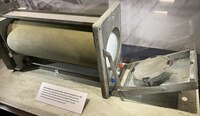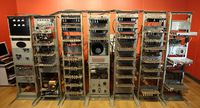The Manchester Baby, the world's first stored program computer, runs its first program
|
21st June 1948 On 21st June 1948, at Manchester University, a newly constructed computer successfully ran its first program. The computer was the Small-Scale Experimental Machine, also known as the "Manchester Baby" and the "Mark 1 prototype". It was built using surplus war supplies, including parts from Bletchley Park, and was the first computer that could run a program stored electronically in its memory. Designed and built by Tom Kilburn and Freddie Williams, the Manchester Baby was never intended to be a practical computer. Rather, it was a proof-of-concept built to test the experimental Williams-Kilburn tube, the first electronic random-access memory (RAM) device. The Baby's memory consisted of just one Williams-Kilburn tube, able to store up to 1,024 bits of information. Nothing remains of the original machine, but the Museum of Science and Industry (MOSI) in Manchester has a working replica on display. Freddie Williams said of the first successful test: "A program was laboriously inserted and the start switch pressed. Immediately the spots on the display tube entered a mad dance. In early trials it was a dance of death leading to no useful result, and what was even worse, without yielding any clue as to what was wrong. But one day it stopped, and there, shining brightly in the expected place, was the expected answer. It was a moment to remember. This was in June 1948, and nothing was ever the same again." Related information:
Image:
Related Items in the Collection:
|
Click on the Images For Detail
|























